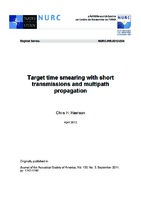| dc.contributor.author | Harrison, Chris H. | |
| dc.date.accessioned | 2018-10-11T14:09:43Z | |
| dc.date.available | 2018-10-11T14:09:43Z | |
| dc.date.issued | 2012/04 | |
| dc.identifier | 42936 | |
| dc.identifier.govdoc | NURC-PR-2012-004 | |
| dc.identifier.uri | http://hdl.handle.net/20.500.12489/667 | |
| dc.description.abstract | In active sonar the target echo level is often estimated with a propagation model that adds all multipath arrivals. If the (post-correlator) transmitted pulse is short compared to the multipath time spread then there is effectively an extra loss (which may be substantial) since only a few of the paths contribute to the target echo at any one instant. This well known "time-smearing" loss is treated in a self-consistent manner with previous calculations of reverberation [Harrison, J. Acoust. Soc. Am. 114, 2744-2756 (2003)] to estimate the target response and the signal-to-reverberation ratio. Again isovelocity water, Lambert"s law, and reflection loss proportional to angle are assumed. In this important short pulse regime the target response becomes independent of boundary reflection properties but proportional to transmitted pulse length. Thus the signal-to-reverberation-ratio becomes independent of pulse length. The effect on signal-to-ambient-noise is also investigated and the resulting formulas presented in a table. | |
| dc.format | 8 p. : ill. (digital, PDF file) | |
| dc.language | English | |
| dc.publisher | NURC | |
| dc.source | In: Journal of the Acoustical Society of America, Vol. 130, No. 3, September 2011, pp. 1282-1286. | |
| dc.subject | Acoustic propagation | |
| dc.subject | Transmission loss | |
| dc.subject | Acoustic reverberation | |
| dc.title | Target time smearing with short transmmissions and multipath propagation | |
| dc.type | Reprint (PR) | |
| dc.type | Papers and Articles | |
